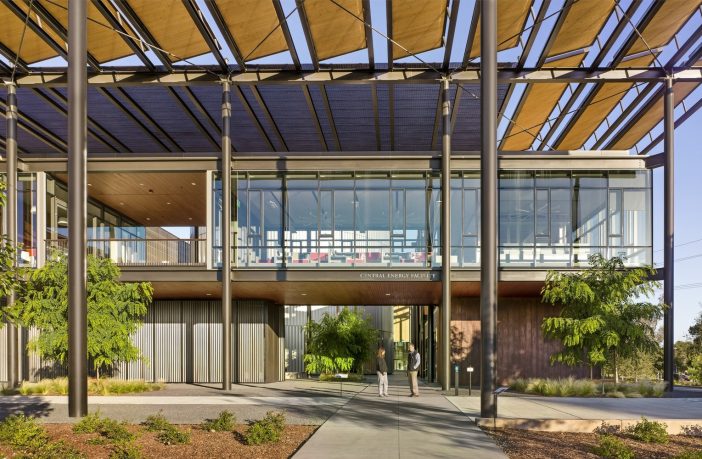- Solar design in contemporary architecture is rooted in the profession’s sustainable turn.
- The relationship between architecture and energy is tied to both passive strategies and performance via more recent innovations in technology.
- As one way to begin addressing the global climate crisis and greenhouse gas emissions, solar design is reshaping cities and architecture around the world.

For many years, architects took aim at energy loads with a focus on reducing the energy that buildings require for cooling, heating, ventilation, and lighting. Solar design encompassed ideas of light and passive approaches, and more recently, to operational and structural embodied energy. Creating energy-efficient buildings has increasingly become a delicate balance, where designing features that decrease the energy needed can actually increase the energy-intensive materials required to build them.
Today, architects and designers around the world have taken steps to minimize the amount of energy that new buildings use, and the emphasis on solar energy and sustainable practices has extended to embodied carbon. The American Institute of Architects recently stated in the Resolution for Urgent and Sustained Climate Action, “until zero-net-carbon practice is the accepted standard of its members, the AIA prioritizes and supports urgent climate action as a health, safety, and welfare issue.” Looking at the connection between architecture and energy, the following articles and projects explore solar design, photovoltaic technology, and more recent innovations that are shaping how we think about the future of the built environment.
How Does Photovoltaic Energy Work?
Once restricted to space stations and satellites, photovoltaics are now gaining popularity and becoming an increasingly viable option. Every day, the sun releases an enormous amount of energy, far more than the entire population consumes. Being that the sun is a sustainable and renewable source for generating electricity, this article aims to explain some basic concepts about this process, and to highlight important considerations for designing a solar energy system.
California Requires Solar Panels on New Homes
The California Building Standards Commission has approved a new rule starting in 2020 that requires all new homes built in the state to include solar panels. As the first of its kind in the United States, the rule includes an incentive for homeowners to add a high-capacity battery to their electrical system. The move hopes to help meet the state’s goal of sharply reducing greenhouse gas emissions while drawing all electricity from renewable energy sources.
Tesla Unveils Fully-Integrated Solar Roof System
Over three years ago, Elon Musk revealed his company Tesla’s latest world-changing innovation: a solar roof system so fully integrated into a home’s architecture as to be indistinguishable from a traditional roof. Made from textured glass, the tiles feature microscopic louvres that allow light to pass through while blocking views to the photovoltaic cell within.
Researchers Improve Solar Panels Using Japanese Kirigami Techniques
Researchers at the University of Michigan sought to develop a solar energy system that could absorb the most daylight possible while reducing the carbon footprint from production of the panels themselves. The results are surprisingly beautiful: through the application of the ancient Japanese art of Kirigami, a variation of Origami, the researchers were able to capture up to 40 percent more sunlight than traditional panels.
Invisible Solar Harvesting Technology Becomes Reality
Solar harvesting systems don’t need to be glaringly obvious. In fact, now they can even be invisible, thanks to researchers at Michigan State University (MSU) who have developed a transparent luminescent solar concentrator (LSC) that can be applied to windows or anything else with a clear surface.
How to Implement Passive Solar Design
In definition, “passive solar energy is the collection and distribution of energy obtained by the sun using natural means”. The simple concept and process of implementing passive solar energy systems have provided buildings with heat, lighting, mechanical power, and electricity in one of the most environmentally-conscious way possible. This article outlines a complete guide of implementing passive solar systems in architectural designs.Author: Eric Baldwin
This article was first published in Arch Daily and is republished with permission.





















